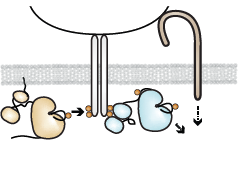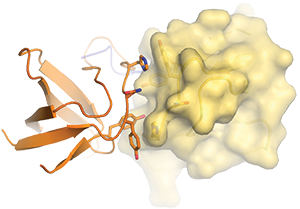Immune-Cell Mediators of Breast Cancer & Autoimmune Disease
Immune-cell responses are triggered by complex networks of signaling pathways that intersect and feed back for higher-order regulation. The various ligands each cell encounters initiate signals through receptor interactions that are then integrated to produce an appropriate effector response. The effectiveness of this regulatory control is the key difference between an appropriate antimicrobial immune response and the chronic inflammation in autoimmune disease. In cancer, the body’s own mutated cells signal to immune cells to perform functions (and fail to perform others) to promote tumor growth, metastasis, and resistence to therapy.
Our lab studies how myeloid cells discriminate between inflammatory ligands to promote different types of responses, and how different basal states can bias the response of myeloid cells to pro-inflammatory stimuli. Immune cells can become dysfunctional by circumventing regulatory signaling blockades to create dysfunctional hyperinflammatory or immunosuppressive polarization states. Identifying the mechanisms driving these dysfunctional states will help us identify key events or lynchpin proteins that may be therapeutically modulated to treat patients with autoimmune disease and cancer.
Select Publications
![]() A dominant function of LynB kinase in preventing autoimmunity
A dominant function of LynB kinase in preventing autoimmunity
Brian*, Sauer*, Greene* (co-first), Senevirathne, Lindstedt, Funk, Ruis, Ramirez, Auger, Swanson, Nunez, Moriarity, Lowell, Binstadt, Freedman
(2022) Sci Adv. 8(16):eabj5227. PMID:35452291
![]() SH3-domain mutations selectively disrupt Csk homodimerization or PTPN22 binding
SH3-domain mutations selectively disrupt Csk homodimerization or PTPN22 binding
Brian, Sjaastad, Freedman (2022) Sci Rep. 12:5875. PMID:35393453
![]() Regulation of myeloid-cell activation (review)
Regulation of myeloid-cell activation (review)
Greene, Brian, Senevirathne, Freedman (2021) Curr Opin Immunol. 73:34-42. PMID:34601225
![]() The Src-family kinase Lyn in immunoreceptor signaling (review)
The Src-family kinase Lyn in immunoreceptor signaling (review)
Brian, Freedman (2021) Endocrinology. 162(10):bqab152. PMID:34320188
![]() ZAP-70: an essential kinase in T-cell signaling (review)
ZAP-70: an essential kinase in T-cell signaling (review)
Wang, Kadlecek, Au-Yeung, Goodfellow, Hsu, Freedman, Weiss (2010) Cold Spring Harb Perspect Biol. 2:a002279. PMID:20452964





